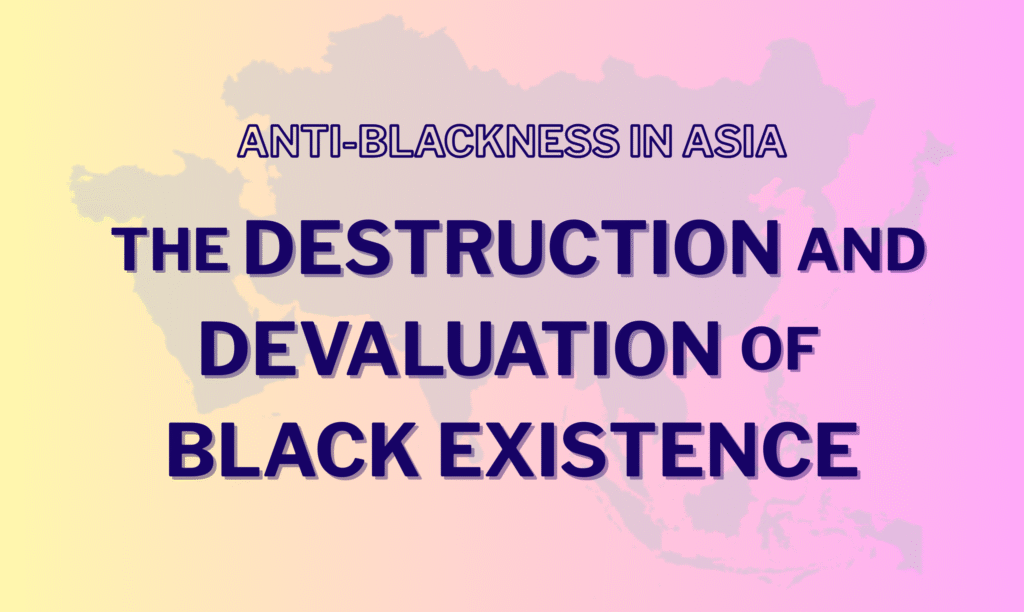An introduction to a new series
I first started working on this series in 2023. At the time, I was reacting to the convergence of several then-recent events: the ruling by the United States Supreme Court that race-based affirmative action in American colleges is unconstitutional, and the campaign for that ruling which utilized Asian-American students as its poster-children; the release of a report showing rampant anti-Black racism on Chinese social media; Indian Prime Minister Narendra Modi’s much lauded visit to the United States in June 2023, despite the fact that the history of Hindu supremacy and nationalism supported by his party is deeply anti-Black; and conversations about anti-Blackness in fan spaces that I inhabited as well. For me, all of these events are evidence of – and impacts of – anti-Black racism in Asia and Asian diaspora.
I am Indian-American and non-Black, and I’ve seen patterns of anti-Blackness within my communities, both Asian diaspora communities where I was raised and in India where my family is from – not to mention online communities where I’ve interacted with Asian people from all over the world! When that anti-Blackness is named, there is usually pushback along the lines of “racism in Asia isn’t the same as in the United States, so it’s not anti-Black”. So I started a research project to help me respond to that kind of pushback by looking at the specifics of Asian communities, highlighting patterns of anti-Blackness in Asian contexts, and digging into their roots.
Many things have changed since 2023, but these dynamics haven’t. Still, you may be wondering why I’m naming dynamics that could sow division between communities of color during a time when global fascism is at another rapid acceleration point, not least in the United States where I live, and when the genocide of Palestinians – who are Asians, to be clear – is so top of mind for me and so many others.
The answer is that I’m not trying to sow division: it is anti-Blackness that creates division, not the efforts to fight it. After all, Black folks are part of every community that is being impacted by fascism and genocide, including in all parts of Asia. And in order to properly resist fascism, genocide, racism, and settler colonialism, we need to be united in true solidarity, which involves working through conflicts. Without Black liberation, there is no Asian liberation. I hope that this series will help us understand better how to fight for both.
Thanks to everyone who gave me feedback on different parts of this series as I researched and wrote it, including Hannah Cross, Roshen Chandran, Stitch, Amu, and Jessica!
Series structure
My purpose with this series is to show that anti-Blackness…
My purpose is not to…
The reason I’m focusing on anti-Blackness in Asian communities because this is a place where I feel I can call in my own community. And there is absolutely no doubt that the United States is one of the primary sources of spreading anti-Blackness and white supremacy across the world, as well as other countries in the Global North. Indeed, you’ll see that a lot of what I talk about is how European and American racist ideologies and practices have influenced Asia through colonialism and globalization. We definitely need to recognize that history in order to understand how anti-Blackness manifests – but that doesn’t give us an out from addressing anti-Blackness in our communities either.
I also want to be cognizant of the fact that when we talk about Black histories around the world, we often focus on racism and the ways that Black folks have been oppressed, leading to paternalistic views and savior complexes by non-Black people. I very much intend to also look at and uplift Black leadership and self-determination in these series to combat those notions. But because I’m pushing back against narratives I mentioned earlier in Asian communities, where folks will claim that anti-Blackness is not a system of oppression in Asian contexts at all, I do feel it’s necessary to start with histories of anti-Black racism in and of itself.
The first part of the series focuses on anti-Blackness in Asia, with the following posts:
The second part of the series will go into anti-Blackness in Asian diaspora, including theories of racialization and Asian diasporic alignment with white supremacy and anti-Blackness. And the third part will look at Black and Asian solidarities since the 20th century, including anti-war and anti-imperialist movements; Afro-Asian internationalisms and Third Worldisms; caste abolition; anti-apartheid movements in Palestine and South Africa; the role of Black power and Black radical traditions in inspiring and supporting Asian diaspora organizing; immigration justice; labor and worker justice; prison-industrial complex abolition; the Black Lives Matter movement globally; smaller-scale solidarities; queer and trans solidarities; and art and culture. You know, just a few quick things to cover. (The second and third parts of the series are not yet written, so they may take a while to come out.)
My positionality
I am a non-Black Indian-American person born and raised in the Pacific Northwest region of the United States. I am from a culturally-Hindu family and am savarna (which means coming from a dominant caste; I’ll be talking about casteism in a future section, but here’s an introduction to casteism to start). I was raised without much religion whatsoever and consider myself an atheist. I am queer, agender, and TME (transmisogyny-exempt). I also have considerable socioeconomic privilege. I have been able-bodied for most of my life until 2022 when I developed chronic illness (long COVID).
English is my primary language, and Spanish is the next in levels of proficiency and literacy for me. I do speak and understand some Tamil and even less Malayalam, my family’s languages, but can neither read nor write in them. The majority of my upbringing and education has been in the United States, although I have also lived in Germany and South Africa for a year each as a kid, in India for five months after high school, and in Argentina and the United Kingdom for a semester each in college.
Some caveats and limitations
The way I’m using social and cultural histories here is challenging and often self-contradictory, because I’m trying to draw out patterns from across giant geographic areas, populations, and even lengths of time, whereas cultural and social histories are often grounded in very specific contexts. But I think these patterns are still worth addressing, even though it means I will often generalize, leave things out, or not thoroughly consider the subjectivity of my sources.
This isn’t a research paper, but I do engage with a lot of academic scholarship, as well as with journalism and personal narratives. I’ve tried to be as careful as I can with using trusted sources, but as I have a ton of them, it’s possible that I’ve missed things. I also only refer to academic articles that are available for free online – if my links go to a paywalled version, try searching the title in google scholar for a PDF or HTML version (sometimes those links aren’t stable enough to link directly to).
I am also limited by the information I can find online and in English or Spanish, so the examples that I give are unfortunately skewed towards the biggest countries and/or those that have significant media coverage in those language, such as former British, Spanish, and/or American colonies. So please treat my examples here as illustrative instead of as comprehensive. Another big limitation of only being able to use sources in English and Spanish is that they are, necessarily, skewed towards colonial perspectives. This is especially challenging when I’m citing anthropological or sociological texts, since both fields have a history of being used as tools for global racism and imperialism (though many scholars are engaged in trying to decolonize these fields from global perspectives). Some of the texts I refer to may perpetuate racism, anti-Blackness, and Orientalism themselves in their perspectives. I have tried my best to only link to texts like that when I have no other choice for a particular data point that I need backed up.
Finally, the paltriness of literature that I can access on Blackness and anti-Blackness in Asia means that the experiences of Blackness that are shared are predominantly of Black cis men, with some available information centering the experiences of Black cis women. Black trans folks in Asia get almost no attention in the media and scholarship I can find in English or Spanish, except for some research about Black Indigenous Papuan trans women in colonized West Papua, almost all of which appears to be documented by non-Papuan anthropologists and sociologists. This is obviously an enormous limitation. (There is more literature on experiences in Asian diaspora, but even then, not as much as I would have hoped.)
A few definitions
For the purpose of clarity, I will refer to historical periods as:
Asia as a continent has over 4.8 billion people and 54 countries, categorized in five very broad regions that are often interpreted differently. Drawing from this article, I am roughly mapping the regions of Asia as:
I’m aware that some of the cartographic distinctions created here are arbitrary and don’t necessarily match other cultural and political dynamics tying different countries together – for instance, including West Papua and Timor-Leste in Asia but other Pacific Islands as outside of it, or treating Southwest Asia separately from North Africa – but I had to draw the boundaries somewhere.
For conciseness, the conversations about diaspora will generally be limited to places outside Asia; that is, if I, for instance, talk about Chinese diaspora communities in Malaysia, I would keep that in the posts about Asia, not about diaspora. Also, when I say “diaspora”, I will generally be referring to Asian diaspora, not Black diaspora, especially since some of the patterns I’m naming appear in Asian diaspora communities in African countries. (Of course, some places will involve both Asian and Black diaspora communities, and there are of course Black Asian folks!) And, again, although my intent is to look at Asian diaspora everywhere outside Asia, being limited to English-language sources will mean that the majority (though not all) of my examples will be from countries where English is widely spoken.
I’ll talk more about this when we get to the series focusing on Asian diaspora, but I do also want to be clear that there is no monolithic diasporic experience; Asian communities experience oppression along certain axes, but there is also variation depending on which Asian communities, and we all have different levels of privilege. That said, for non-Black Asians, there are still key differences in how we experience oppression compared to Black folks, and I think that’s important to name from the start.
We’ll be defining more terms in the posts to come, including what I mean when I talk about Blackness and anti-Blackness themselves in an Asian context. Stay tuned!
[1] I have chosen to focus on social and cultural histories instead of on geopolitics, so I will only be looking at the relationships between governments where it feels especially pertinent to me; otherwise, I will mostly focus on how anti-Blackness impacts people and communities rather than states as a whole.
[2] Cultural studies scholar Roberto Castillo points out that, in scholarship and discourse around Sino-African relationships, there’s a tendency to racialize the prejudice exerted by Chinese people towards African people, and de-racialize the prejudice exerted by African people towards Chinese people. That is not my aim with this series. There are other spaces for conversations about racism against Asian people, and nothing I say here is meant to conflict with those discussions.







